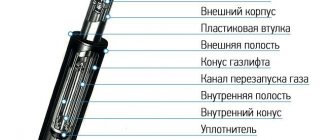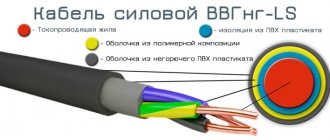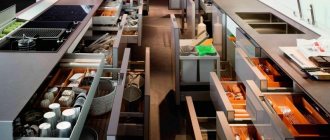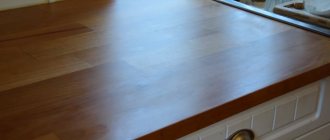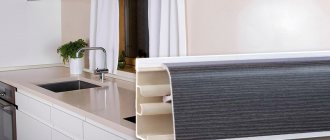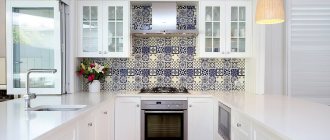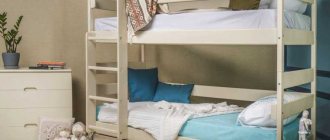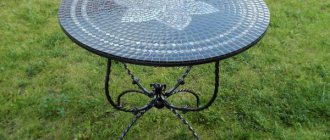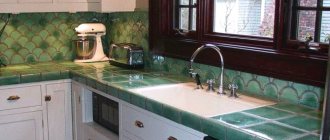To ensure the most comfortable operation of household appliances, so that the power wires do not become annoying interference, it is necessary to conveniently place the points of their connection to the electrical network. At the same time, it is always recommended to do without additional extension cords, and for some models of household appliances they are completely excluded. Sockets in the countertop become a convenient aid for optimal organization of such placement.
Tabletop sockets: types, features and selection rules.
These devices are blocks that usually contain several sockets that allow you to simultaneously connect several household appliances to power. The blocks can have a built-in or retractable design; their color and texture are matched to the working surface of the table, so they fit harmoniously into the interior design of the room. Practicality, ease of installation and operation have become the basis for the popularity of such devices. A wide range of models of various designs and sizes are available for sale. Therefore, before settling on a specific option, it is worth familiarizing yourself with some of the nuances of choosing such “devices”.
What are countertop sockets?
Sockets built into the countertop are an original engineering development of leading manufacturers of electrical appliances. Such products provide not only their comfortable and safe use, but also an elegant appearance. Thanks to this, built-in sockets not only solve a number of problems, but also do not spoil the style of the room.
Block sockets built into the surface of the countertop will greatly simplify the operation of household appliances, especially in the kitchen.
Blocks with a set of sockets are made of plastic or metal. They are equipped with special fuses, which make their operation safe. If desired, products can be built into not only countertops, but also floors, as well as shelves of cabinets and cabinets, which makes their use as convenient as possible. High-quality sockets are highly reliable, as their design is thought out to the smallest detail.
When not in demand, the device is hidden under the surface in which it is built. It is not difficult to extend or open it when the need arises - for this purpose, a special button or lever is provided in the block cover. There are models equipped with a remote control, which allows you to pull the block out of the surface without touching the product, which is quite convenient in a kitchen with high humidity. In addition, built-in sockets allow you to maintain order on the table and do not interfere with the use of its surface for its intended purpose.
The socket block usually has two or more sockets, which makes its operation comfortable, since several household appliances can be connected at the same time.
The advantages of built-in socket blocks include the following:
- Safety of operation of sockets. This factor is due to the fact that the main cable connecting them to the electrical network is located under the tabletop, which reduces the likelihood of mechanical damage to a minimum. In addition, the unit hidden in the table is reliably protected from moisture getting into it, and therefore from short circuits.
- Inaccessible to children.
- Hidden devices practically do not occupy the surface area of the table, which is especially important given its small linear dimensions in small kitchens. This factor allows you to place on the countertop a larger number of appliances necessary for work, and in the kitchen - utensils and processed foods. However, it should be taken into account that it is not recommended to subject the top cover of the unit to high loads, place hot kitchen utensils on top of it, or place wet fruits and vegetables.
Hidden socket blocks, additionally equipped with USB and (or) HDMI connectors.
- Some models of block recessed sockets provide HDMI or USB connectors. This allows you to connect mobile phones, tablets, laptops and other devices. Such functions are especially necessary on computer desks or bedside tables.
- Rational organization of the workspace of the table top even when using a corner table design.
- Neat appearance, as well as the ability to use products in different interior styles.
Types of built-in sockets
Most users note that they are tired of the numerous wires and extension cords with which they have to connect various gadgets to the network. Cables often interfere not only with work, but also with movement around the room. That is why many, when carrying out repairs, prefer compact block versions of sockets that can be built into a table or cabinet. Moreover, the modern range of such models is quite wide.
Socket prices
sockets
Built-in socket modules, both horizontal and vertical, are usually equipped with several sockets for connecting power plugs
All models of these devices are quite comparable to built-in household appliances. They not only save space on countertops in small kitchens or on computer tables, but also greatly simplify the use of appliances. In addition, very often they eliminate the need to lay an additional power supply line to connect newly appeared devices.
Built-in blocks are divided into types depending on their location. Thus, products can have a vertical retractable or horizontal rotary or stationary design. The following features are common to most embedded devices:
- The units are usually equipped with an additional illuminated on/off button. The backlight will be a reminder that the unit is on, so when finishing work it will not let you forget to disconnect it from the network, if necessary.
A special brush installed in the front part of the unit will protect it from contamination, and will also sweep away dust directly from the connectors when closing the lid.
- The blocks have different classes of protection from dust and moisture. When purchasing a product for installation in the kitchen, you should choose models of IP44 class and higher, since this room may contain high humidity, grease fumes, and small dust particles. However, dust is present in the air of all rooms.
- Socket blocks are usually equipped with grounding contacts - this factor is especially important for products mounted in the kitchen, as it ensures the safety of a person working in a damp environment from electric shock.
- Versatility of designs. Almost all models can be built into the tops of tables and cabinets, or into the bottom or side panels of wall cabinets.
- The units can be equipped with a cable with a length of 1000 to 3000 mm and a plug to connect the unit to the network. However, some models go on sale without a cable - you will have to install it yourself.
- The plugs on the cable can be removable or non-removable. The collapsible version is convenient because it allows you to extend the cable without disconnecting it from the unit.
Vertical pull-out built-in units
Vertical versions of blocks differ in height, as well as in functionality. This type of product is usually made in the form of a cylinder, that is, a round or oval cross-section, along the height of which the connectors are located. Most often, the block has from two to five sockets installed in a row, one above the other.
The mechanism for lifting the block from the tabletop in different models may differ in design and principle of operation.
Therefore, the height of the product depends on the number of nests. As mentioned above, the unit may include connectors for standard household appliance plugs (with a grounding contact), as well as for charging a phone, tablet and other gadgets, as well as connecting them, for example, to a home information network.
Pull-out vertical socket block in open and closed position.
Vertical blocks belong to retractable structures, as they rise, that is, they are pulled out from the surface of a tabletop or cabinet up or down using special mechanisms. In addition, they are designed to rotate 180 or 360 degrees around their axis, which adds comfort to their operation. Some models are equipped with LED backlighting, which also provides a certain ease of use.
Lateral installation of a pull-out unit into a cabinet panel.
The advantage of blocks of this type is that the penetration of moisture into the structure, both closed and open, is completely excluded.
Prices for Legrand sockets
legrand sockets
Pull-out socket block mounted in the bottom panel of a hanging cabinet.
In addition, it is possible to install the same model of socket block both in the surface of the tabletop and in the bottom of the wall cabinet, so it can be called universal. Mounting the unit in the lower part of the cabinet will completely free the table from sockets, and will also eliminate the possibility of direct exposure to moisture on the electrical device.
A retractable unit built into the table surface.
Installing a retractable structure cannot be called difficult, especially in cases where you have some experience and have all the necessary tools to carry out the work. The main thing is to choose a model that can fully satisfy the need for the number of sockets.
The sequence of actions when connecting an electrical appliance to a retractable socket module.
The principle of using a retractable block is quite simple - it is presented in the figures and includes several operations:
- To raise the device cover, which is recessed flush with the surface of the countertop, you need to press one of its sides in the place specified by the manufacturer. In other models, a special handle is provided for this purpose, which is placed flush into the block cover, and, if necessary, can be easily lifted up at an angle of 90 degrees.
- The lid lifts completely, which makes it possible to move the moving part of the block out completely. It is pulled out until it is fixed in the stationary part of the block structure, fixed to the tabletop. Fixation is carried out using a special stopper.
- Next, the sockets turn on electrical appliances, one or more.
- Moreover, if one device is permanently connected to the block, for example, an electric kettle, then the block with one connected cable can be immersed back under the countertop. One side of the lid will remain slightly open.
An example of how a retractable unit can be used by almost completely closing the protective cover after turning on the device.
To completely remove the device, you need to remove the unit and remove the plug of the device being disconnected from the connector. Then, pressing your finger on the cover, wait until the block goes completely down and locks in the lower position. The lid will be flush with the surface of the countertop.
Horizontal rotary and stationary blocks
Horizontal models of socket blocks can consist of one or more power connectors. In addition to standard sockets, they, just like vertical ones, can be equipped with sockets for connecting the Internet, video, and for charging gadgets.
Horizontal models are also very convenient, and they are even somehow simpler...
Horizontal models are produced in different shapes - it can be a square, rectangular, round or oval box hidden in the tabletop or mounted on it.
Depending on the design features, horizontal sockets are divided into several types:
Rotary models of built-in socket blocks.
- Rotary socket models are a structure consisting of a box and a block with connectors on which the top cover is fixed. The panel with sockets opens by rotating the block and installing it at an angle relative to the table surface, approximately 50–60 degrees. This arrangement is convenient for operation, as well as for opening and closing the lid. Such models are considered more reliable options for built-in sockets, as they have a durable design and a large mounting area on the table surface. In addition, the location of sockets in an open position reduces the risk of moisture getting on current-carrying parts
A button or key will help you open the rotary block cover.
To open the rotary block, just press the button provided for this purpose, located on the top panel, next to the lid. In some models, to open the sockets instead of a key, you just need to lightly press the surface of the cover. In any case, after applying very little force to the button or cover, the unit rises and turns the panel with sockets into a position convenient for connecting the plugs.
- Blocks with sockets that are permanently built into the countertop. In this case, to open the panel, only the lid is used, which can have a regular folding mechanism or a sliding rotary version. The block itself with sockets is rigidly fixed to the tabletop.
Double built-in socket with horizontally rotating cover.
Such models have a more affordable price, but are not recommended for use in the kitchen, as there is a risk of water getting inside.
A block fixed to the end of the tabletop panel.
- Another option for block sockets is installed and secured to the edge of the tabletop and does not have a protective cover at all. It can rather be called desktop than built-in, but just like other options it has the ability to significantly save space on the table. Such a block can be fixed to the free end of the table or between its surface and the wall. The design will also not take up much space and will not interfere with storing items necessary for work. However, it should be remembered that when placing open sockets in the kitchen, they should not be located near the sink to avoid water splashing into them. The best option is to use such devices on a computer or desk.
Possible options
Modules of this kind are considered an original solution in any kitchen. They are practical to use and often complement the design of the room. Currently, you can purchase a variety of models, unusual designs in the desired color.
A luxurious solution is the use of sockets built into the kitchen cabinet. This is an excellent analogue of an extension cord, which significantly simplifies the operation of household appliances.
According to their design, sockets are distinguished between horizontal and vertical placement.
Vertical sockets are manufactured with different heights and have certain functionality. Particularly popular are low versions in which the connectors are arranged in a circle.
There are options for two, three, five or more blocks, placed one above the other. They are relevant not only for connecting kitchen appliances, but also, for example, chargers.
Horizontal blocks are made with different numbers of power connectors. Now you can even purchase sockets with integrated input for the Internet, HDMI and USB.
Depending on the design, built-in blocks are:
- rotary;
- away.
Sockets can change their position in space around an axis by 360 or 180 degrees, respectively.
A number of manufacturers equip their products with additional lighting, due to which the room acquires a special, mysterious atmosphere.
The greatest reliability and ease of operation are typical for rotary sockets. Disadvantage: difficulty in simultaneous use of several devices with an “L-shaped” plug.
Recessed socket blocks are usually located in various places in the kitchen area, including: the countertop; wall cabinet; baseboard under the apron.
They are considered universal, since installation of the same block is often possible in different parts and elements of the kitchen. This type of socket can be placed in almost any convenient place on the headset.
It is important to consider that when choosing furniture fittings, you must always pay attention to its degree of protection. It is desirable that the hidden modules meet the IP44 requirements, since the kitchen is considered a room with high humidity, as well as a place where there is a possibility of small particles, dirt, etc. getting into the working elements.
Criteria for selecting built-in socket modules
Specialized stores offer a wide variety of socket blocks built into countertops from different manufacturers. In order to choose a suitable option from the entire assortment that will meet all the necessary criteria, you first need to formulate them.
A correctly selected socket block will last a long time.
- The first thing you need to do is decide how many sockets, as well as additional connectors, will be needed in a given location. It is not difficult to decide on this issue by counting the number of electrical appliances, and, probably, also thinking about the reserve. You may need to purchase several blocks and spread them across the countertop.
- The second thing to consider is personal safety, especially when you plan to install the unit in a kitchen countertop. The selected model must be equipped with grounding contacts.
- The third criterion is the permissible total power of the load simultaneously connected to the unit. Each block is designed for a specific load that it can withstand. Therefore, the sum of the power of electrical appliances planned for connection should not be higher than that indicated in the passport of the outlet module. And it’s better, of course, to choose an option that also has a service margin of 25 percent. This product parameter also needs to be known in order to select the correct cable cross-section if it is not included with the main product. To find out the maximum load of the unit, you need to pay attention to its technical characteristics specified by the manufacturer in the instructions that come with it.
Built-in units can be designed for 10 or 16 amperes, that is, for a total load of up to 2.2 and 3.5 kW. Naturally, one should exercise prudence and not bring the load to the specified limit.
Prices for built-in sockets
built-in sockets
How not to get confused in terms of current, permissible load and conductor cross-section?
This issue is so important that it requires more serious consideration. Mistakes are unforgivable - they can very well lead to an extremely dangerous situation. This is described in detail in a separate publication on our portal dedicated to choosing a cable for home wiring .
- The fourth thing that is taken into account is the manufacturer of the product, since the quality, duration of its operation, as well as safety in operation directly depend on this. You can find products from both foreign and domestic companies on sale. It is recommended that before choosing a particular model, you study the reviews of those users who already have experience in using such an outlet module.
- Fifth - the degree of protection of the device from moisture and dust. It has already been noted that for installation in the kitchen it is necessary to choose models of a class not lower than IP 44. But for a desk or computer desk, you can get by with a lower class, even IP20. Naturally, the higher the class, the more expensive the built-in socket modules.
The external design of the outlet module is already a pure choice of buyers, and it is problematic to give advice here.
- Sixth is the external design of the block. But it’s difficult to give advice here - people have different tastes. Some people like the socket module to be almost invisible in the closed position. Others, on the contrary, want it to contrast on the countertop. There are many models on sale that will satisfy both sides. That is, devices are produced with lids matching the color of the countertops, or made in various shades, including with a noble metallic sheen.
- The seventh criterion is the performance of the device. That is, when purchasing, you should carefully inspect the product for defects and check the operation of the opening and locking mechanism. In addition, the completeness is checked - it must be indicated in the model passport.
Some information about the manufacturers
When purchasing recessed sockets, you must place your bet on a trusted manufacturer. The most popular today are the products of the German company Evoline, the Swiss company Kondator, and the Italian factory Simon Connect. From the French it is worth highlighting Schneider Electric, the Poles - GTV, and the Russians - Ekoplast. Most often, submersible sockets are made from high-quality and durable materials.
Companies that have been in the kitchen accessories market for a long time try to monitor reviews of their products and guarantee their trouble-free operation. If a regular overhead socket is not suitable, and you don’t have enough money for a good brand, you can easily get by with “Chinese” ones, including Desc Socket or Displace. Mortise blocks are visually very similar to the original prototypes, but may be significantly inferior to them in manufacturing quality.
Chinese sockets, as a rule, are made from very cheap components, which is why their performance is limited to 6-12 months. Problems may arise gradually. At first, the integrated block opens on its own and does not lock in the specified position. After this, the contact weakens, the plastic begins to heat up, which ultimately leads to failure.
It is advisable to protect the corresponding power lines with good differential circuit breakers.
It is incredibly easy to find a suitable option that matches the kitchen interior and furniture design. Recessed, pop-up sockets are available in various colors. Particularly appreciated are options finished in natural gold, silver, bronze, polished stainless steel, with black, white and other coatings. Before purchasing, the selected item should always be checked for damage and completeness.
Choosing a location for installing built-in socket modules
At the stage when the number of required connection points will be calculated, it is worth deciding on the location of the outlet blocks. First of all, you need to pay attention to the convenience and good accessibility of sockets.
If built-in units will be installed in the kitchen, it should be taken into account that household appliances can be located on three levels.
- The lower level is the area of floor cabinets, next to which a washing machine, dishwasher and oven are installed. Sockets for these devices are usually installed individual stationary, and mounted 150÷200 mm from the floor surface. For powerful equipment, as a rule, separate lines are provided with a cable of the appropriate cross-section, equipped with both a grounding loop and an RCD. Of course, you shouldn’t connect such equipment to sockets built into countertops.
Average level of placement of household appliances in the kitchen.
- The middle level is a countertop with small household appliances placed on it, which include a food processor, electric kettle, coffee maker, blender, etc. That is, this is exactly our case - built-in units are perfect for these devices. Moreover, ordinary sockets installed on the kitchen “apron” will only spoil its design. That's why many owners try to hide connection points by building them into the countertop.
- The third level runs approximately 800÷1000 mm above the tabletop. There are not many appliances located here - a range hood and a microwave oven. If they are located in the same row as wall cabinets, then pull-out or rotating units can be built into the walls or bottom of the latter. You can install sockets for connecting the above-mentioned devices above the wall cabinets, 100÷120 mm away from their surface. These connectors are also suitable for connecting a fan or air conditioner. That is, they usually make do with stationary sockets again.
On a desktop (computer) desk it’s a little easier. It takes into account the number of possible peripheral devices that require connection to a power supply or other switching (IP, HDMI, USB, etc.); the location is selected for reasons of maximum convenience for the user. Since there should be no contact with water, there are no other restrictions.
Safety precautions
It should be correctly understood that the very essence of built-in retractable and rotary socket blocks is that they are used to connect devices with low power, and as the need arises. The rest of the time the module is in a hidden state. That is, as already mentioned, always-on appliances such as a refrigerator, microwave, washing machine or dishwasher, stove or oven, desktop computer or TV must be connected to regular sockets specially placed for them in a convenient location.
- You cannot install built-in units so that, when open or closed, they are above or below the hob, sink, or on the countertop, but too close to these kitchen areas.
These requirements are determined by safety rules, since water or steam entering the module can lead to a short circuit, and overheating of the block can lead to its melting and deformation. The distance that must be maintained between the named devices and the socket block is at least 600 mm.
- In addition, you should be aware that water spilled abundantly on the unit cover can still penetrate inside the mechanism. Therefore, before sliding the device under the tabletop, do not forget to press the button to turn it off from the network - this will protect it from short circuiting in the event of an emergency.
- If water got inside the unit when it was turned off (with the key), it should be completely disconnected from the network. Then you need to invite an electrician to determine the serviceability of the device and the possibility of its further operation.
- You should not set the maximum load to the outlet, especially if the manufacturer of the product is unknown, which means there is no guarantee of its quality.
- When turning the plug into the retractable vertical unit on and off, it should be held with your hand. Otherwise, you can quickly damage the “mechanics” of the module.
In product data sheets, manufacturers always give their own recommendations for the safe operation of such devices. Never skimp on these tips!
World famous manufacturers
The Russian market offers products from the following manufacturers:
- Schulte Elektrotechnik,
- Kondator,
- Simon.
Built-in sockets in the countertop from Kondator
A world-famous German company has been producing Evoline sockets since 1964. They are distinguished by stylish design and excellent quality. Vertical, horizontal and open designs are offered.
Kondator is a company from Switzerland. It produces PowerDot recessed sockets and SmartLine hidden units. They can include USB, HDMI and Internet devices.
The Italian company Simon produces sockets for offices. They also perform some additional functions. Similar products are produced by dozens of enterprises that are less known to the buyer. After about six months, Chinese products surprise their owners with their character. They open and close on their own and get stuck in their sockets. Therefore, you need to check them carefully.
Installation of sockets built into the countertop
It is quite easy to install both retractable and rotary sockets on your own. If the module is planned to be built into a countertop in the kitchen, then it is best to carry out this process while installing the set - this will make the task much easier.
If the idea of installation came later, when the kitchen was already installed and in use, then coping with the task will be somewhat more difficult, but still possible.
To carry out the work you will need a set of certain tools. The main thing is that when installing the blocks, you do not have to strip the walls to lay a separate power line.
The main difficulty in installation work can be found in cutting a window of the required shape in a table top or in one of the panels of a wall cabinet. Depending on what material the furniture is made of, drilling or cutting an opening may even require the involvement of specialists. This is due to the increased strength of surfaces that are not amenable to a conventional drill or jigsaw.
For example, if the countertop is made of tempered glass, artificial or natural stone, or other difficult-to-cut material, then not only a special tool is required, but also stable skills in working with it.
But if the countertop is made of wood or a wood-based composite material, then hand-held power tools - a drill and a jigsaw - will do.
First, let's look at the installation of a rotating model of a socket module built into a countertop
Built-in rotating horizontal module, prepared for installation in a countertop.
The work is performed in the following order:
| Illustration | Brief description of the operations performed |
| The first step is to disassemble the block and separate the lower box from the upper part, which consists of a frame with a button for opening the lid, a rotating panel with sockets and a protective cover. To do this, you will have to unscrew two screws located on the sides of the frame. After unscrewing, the upper part is removed from the plastic box. | |
| Next, the exact location of the module on the tabletop is determined, and markings are made to cut out a slot for installation. Marking can be done using a construction square and a ruler according to the dimensions specified in the passport, or even simply along the contour of the box if it has right angles. To do this, the box is installed in the place of future installation and traced along the bottom line with a pencil. | |
| The next step is to drill through holes at the corners of the intended rectangle, but without going beyond its boundaries. Their diameter should allow the jigsaw file to be inserted. | |
| The next step is to insert the jigsaw blade (with it turned off, of course) into one of the holes, and cut out one of the sides of the rectangular opening. This operation will be repeated until the entire fragment is deleted. The holes will help in forming neat corners of the window. | |
| The block box is inserted into the cut out rectangular window. In this example, it has four mounting “ears” with holes for self-tapping screws. These eyes should be outlined with a pencil, since it is necessary to select grooves under the “ears” - they should not protrude above the surface of the table top. | |
| Now, according to the mark, using a drill of the appropriate diameter or cutter, grooves are selected into which these eyes will fit. The work should be done very carefully, holding the drill at a right angle to the surface of the countertop. Only 1.5÷2 mm of the thickness of the tabletop is selected, and it is important that the sampling depth on different eyes is practically the same. | |
| The next step is to install the box in the opening, the lugs are aligned with the selected grooves. Then, through the holes in them, this part of the structure is screwed to the tabletop with four self-tapping screws. The heads of the screws should not protrude above the level of the countertop. | |
| The next step is to install the functional part of the block into the box. Pressing the key opens the protective cover, revealing the sockets. | |
| Under the cover on the frame framing the panel with connectors, there are two holes through which the functional part is fixed to the box using two screws. | |
| The frame should fit snugly to the table surface. Some models are recommended to be installed with an elastic self-adhesive gasket, which may be included in the kit. Now that the unit is installed, it can be tested. Opening should be ensured by lightly pressing the lid. Accordingly, when closing the lid should lock securely. If everything is fine with this, you can carry out “electrical tests”. The standard cable of the unit is connected to a stationary socket, discreetly located on the wall under the tabletop. And some household appliance, for example, a kettle or coffee grinder, is plugged into one of the sockets. If the connected device starts working, it means the installation was successful. |
If a retractable model in the form of a cylindrical column is chosen for installation, then it is even easier to install than a rotary block, if only for the reason that the window cut out on the tabletop is smaller. It is enough to have an electric drill and a core drill of the required diameter on hand.
Design of a retractable cylindrical model of a socket module.
The retractable model consists of a lower block along which the functional socket module will move. This lower part has a thread on the outside, onto which a special nut is screwed, pressing the part to the surface of the tabletop. On the bottom side of the functional part there are connectors through which the unit is connected to various communication lines, and on the panel next to the usual sockets there may be connectors for special purposes, which were already mentioned above.
Scheme of installation and operation of the retractable block.
The installation procedure for this type of built-in module is as follows:
- A hole of the required diameter is drilled in the intended location using a core drill. In this example, the illustration shows a diameter of 80 mm. If you don’t have a core drill, then a round window can be carefully, slowly, cut out using an electric jigsaw along the circle marked with a compass.
- Next, the module body along with the functional block is inserted into the cut-out opening from above. The threaded part of the “column” ends up under the tabletop.
- After this, a fastening nut is screwed onto the thread under the tabletop, which will secure the structure in the opening. From above, the module will rest against the tabletop with a protrusion running around the circumference, which will immediately cover the edges of the window. The nut also has a wide “skirt”, which will ensure that the stationary body of the socket module is pressed against the tabletop.
- Next, the device is connected to the necessary communications and to the electrical network. That's it, installation of the device is complete, and you can proceed to testing it.
It is clear that only two examples were considered, and other models may still have their own installation features. But we dare to assure the reader that nothing overly complicated awaits him one way or another.
Retractable
Pull-out sockets, also called hidden or built-in, are mounted directly into the countertop or the bottom of wall cabinets. Free sockets are not visible, all wires are also hidden under the table, which is especially convenient for the layout of a kitchen-living room apartment. Simply press the lever for the socket to extend to the desired height.
Advantages
- universal sockets;
- take up minimal space;
- ideal for small and non-stationary electrical appliances;
- There are waterproof, grounded and childproof models;
- fits perfectly into modern design;
- can be vertical or horizontal;
- They are simply mounted into a solid wood tabletop; they can be embedded into any surface;
- You can purchase options with additional sockets for telephone, Internet, audio output, cable TV, mobile phones.
Flaws
- relatively high price;
- take up space in a closet or under a table;
- cannot be mounted in a countertop above drawers;
- vertical ones can break upon impact or become loose from constant use, so they are not suitable for dependent sets of built-in furniture.
Well, such sockets are suitable for temporary work
Manufacturers of built-in socket modules
In order not to make a mistake and choose a high-quality socket module built into the countertop that will last for a long time, it is worth knowing which manufacturers’ products you should pay special attention to. And which ones, on the contrary, are recommended to be abandoned, even if they are attractive due to their low cost.
The Russian market offers products from well-known and consumer-trustworthy companies from Italy, Sweden, Poland and Germany, as well as domestic manufacturers, among which the Ecoplast brand deserves special mention. Let's start with a short review:
Retractable socket module "Ekoplast".
- "Ekoplast" (Russia) is a company producing various plumbing and electrical products made of plastic. This manufacturer has been on the market for 15 years, and in this short time it has managed to gain recognition not only from domestic but also from foreign consumers. Evidence of this is the quality certificate of the international standard ISO 9001:2008, as well as the Russian standards GOST R ISO 9001-2008. The quality of Ecoplast products is officially confirmed by accredited EU laboratories and complies with their standards according to Directive 2014/35/EU. That is, you can safely purchase.
- "Schulte Elektrotechnik" (Germany). This is a German company that can rightfully be called one of the first developers of built-in units. The quality of this manufacturer's products is recognized by consumers around the world, and, of course, is certified according to EU standards.
"EVOLINE PORT" socket module
- "Evoline" (Germany) - a manufacturer known in many countries around the world, offers a number of models built into countertops, cabinets and floors. All products are of high quality and stylish design. Evoline supplies the market not only with closed built-in units, but also with various open single and block sockets, which expands consumer choice.
"Kondator 935-PF02B" is a module built into the countertop.
- Kondator (Sweden) also presents built-in units of both open and closed types. Most models are equipped not only with sockets for connecting to the power supply, but also with other connectors mentioned above.
Retractable module "Kontakt Simon ktl".
- Simon (Spain) is a well-known manufacturer of electrical products. The product range of this brand includes many models of built-in retractable and rotary socket modules.
Built-in socket “GTV AE-pbu02gs-10”
- GTV (Poland) has been active in the international market for more than 20 years. The company produces high-quality products that are affordable to consumers and are fully certified according to European standards. Although the brand is not so “loud”, the products are of high quality, and you can purchase them without fear.
Now, a few words need to be said about products that, in the opinion of users who have already tried them in their work, are not worth purchasing, since they did not live up to expectations. As you might guess, these include some Chinese companies that widely represent their products on the Russian market. The situation is aggravated by the fact that purchases most often occur “contactlessly,” that is, through online stores. That is, it’s impossible to even visually assess the quality of a product or “twist it in your hands” before purchasing.
Although, at first glance, the products look quite attractive, their reliability, according to customer reviews, is very doubtful.
Built-in block "Displace"
- “Displace” blocks have a rather interesting design, equipped with power connectors, as well as HDMI, USB and other sockets. When installing devices from this manufacturer, they function normally for the first six months, and then various “miracles” begin to occur in their operation.
- "Desc Socket". Modules from this manufacturer can have up to 17 different connectors and work perfectly for the first six months. After this time, their lids open with difficulty, and this process is accompanied by creaking. There are malfunctions in functioning, individual connectors stop responding to switched on devices, cracks may appear on the housing, since the housing is made from cheap raw materials.
The named products can be manufactured in China or in Russia, but from Chinese components, which does not add quality to them and does not increase the period of trouble-free operation. Therefore, purchasing such products is not recommended. Moreover, they can be a fire hazard, since it is unknown how the plastic will behave, as well as the “filling” of the functional part of the module.
* * * * * * *
We hope that the information presented above will help the reader decide on the choice of a built-in socket module. If all installation recommendations are followed and the criteria for evaluating the device are taken into account, then such a module will be an excellent help in the kitchen or on a computer desk, and at the same time will help save free space on the countertop.
Built-in retractable Evoline Port sockets
Press the recess, pull the cover and pull out the socket,
connect the cable and push the socket back.
There will be space between the cover and the panel for free passage of the cable
— The retractable block made of aluminum profile is equipped with a current set of connectors for connecting to electrical, computer, telephone networks, audio and video outputs
— Aluminum profile colors: silver, antique bronze
— Some models have a night light function. Soft lighting from 6 LEDs located under the cover. Backlight colors: blue, ruby (only for “antique bronze” version)
The lid can be made of plastic (standard colors: black, silver, antique bronze) or stainless steel.
Advantages
By using a built-in socket block, the user benefits from the following:
- the design remains infallible. The built-in unit can be plugged into a socket located below, for example, under a table, or a cable can be connected to it under the baseboard, so that no electrical points will be visible at all;
- installation is extremely simple. Installation of the block takes about an hour and is almost not accompanied by the formation of dust and dirt. In this case, the user receives several additional sockets at once. Installing the same number of stationary sockets will require much more labor - you will have to beat the grooves. After this, the kitchen renovation will need to be redone;
- In addition to regular power sockets, you can connect connectors for transmitting audio signals, video (HDMI), Internet (RJ45), USB. Initially, stationary sockets do not have such connectors, and to install them, you will again have to pay fines.
The devices also have disadvantages:
- high quality requirements . Due to the presence of moving elements and latches, the built-in socket block is more complex than a stationary socket, so you should be picky when purchasing. Low-quality models quickly fail: the latch stops holding (spontaneous opening), contacts on the moving part break off (sparking is possible);
- limited power . There can be as many sockets in the socket block as you like, but it is powered by just one cable. This means that the total power of the switched on devices cannot exceed the maximum permissible for the power outlet. If it is powered, for example, by a copper cable with a cross-section of 2.5 square meters. mm, then no more than 4.6 kW of total load can be connected to the socket block, even if there are free sockets left. In this parameter, stationary sockets are superior to a socket block: each of them is connected with a separate wire, therefore the maximum permissible total load for them is much higher;
- low class of dust and moisture protection . Due to design features, it cannot exceed IP44. This is enough for the kitchen, but in more difficult conditions, socket blocks cannot be installed. Fixed sockets can have a dust and moisture protection class of up to IP67.
The products of the following brands are worthy of trust:
- with an affordable price : Ekoplast (Russia), GTV (Poland);
- expensive : Evoline (brand of the German company Schulte Elektrotechnik), Legrand (France), Simon Connect (Italy), Kondator (Sweden).
Principles for placing sockets in the kitchen
The kitchen has the greatest concentration of electrical appliances, especially if an electric one is installed instead of a gas stove.
It is customary to install stationary sockets here in three tiers:
- lower _ Electric points are located at a height of 15-20 cm from the floor and are used to connect powerful floor-standing appliances - a refrigerator, a dishwasher, a washing machine, and an electric stove. Devices with high power are supplied with separate lines from the distribution board. The listed equipment is usually not unplugged from the sockets, therefore the lower location of the latter is convenient: they are not conspicuous, and the wire lying on the floor does not get tangled underfoot;
- middle tier These sockets are used to connect mobile and tabletop kitchen appliances: blender, electric kettle, toaster, electric meat grinder, microwave, juicer, etc. Such devices are connected to sockets only for the time of use and therefore they are placed at a height of about 1 m or above the table - so as not to I had to bend over every time. Devices of this type do not have significant power, so the sockets for them are combined into an outlet group: they are powered by a common cable and protected by one circuit breaker;
- upper tier Closer to the ceiling there are electrical outlets for the hood and air conditioner. These devices do not turn off from the socket.
There is a twofold situation with middle tier outlets. On the one hand, there should not be a lot of them: it looks unsightly (sockets at this level are especially striking) and this is not necessary, since the devices are turned on from time to time and not at the same time. On the other hand, sometimes circumstances develop in such a way that when the quantity is small, there is a catastrophic shortage of them.
Standard situation: there is a pair of sockets above the table and the user, if necessary, hangs them with tees or extension cords. Then there is no need to talk about design at all. A better solution is to connect built-in socket blocks to these sockets.
Video on the topic
Instructions for installing a block of retractable sockets built into a kitchen countertop:
An electric kettle, mixer, coffee grinder and many other devices, and even a charger for a smartphone - all this needs to be plugged in somewhere, and stationary sockets are not installed anywhere in such quantities. We can safely say: a built-in socket block will not be superfluous in any kitchen.
There will be no problems with powering the appliances, while the kitchen will retain its attractive appearance - without a clutter of tees and extension cords. You just need to remember that the total power of the connected devices is limited by the throughput of the power cable.

